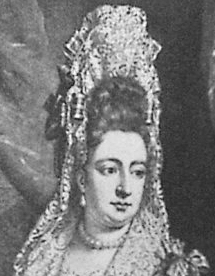Fontange facts for kids
A fontange was a very tall and fancy headdress that was popular for women in Europe around the late 1600s and early 1700s. It was a complex style, often made of lace, ribbons, and linen. The name "fontange" actually refers to the ribbon bows that helped hold up the main part of the headdress, which was called a frelange. This tall, layered look was held up by a hidden wire frame called a commode. In England, people often called this fashionable headdress a 'top-knot'.
Contents
What Was a Fontange?
The fontange was more than just a simple hat. It was a towering structure that could reach impressive heights. The main part, the frelange, was usually made of layers of pleated lace or linen. These layers were carefully arranged to create a fan-like or tiered effect.
The Parts of a Fontange
To understand this elaborate headdress, it helps to know its different parts:
- Frelange: This was the main, tall part of the headdress. It was made of soft materials like lace, linen, or muslin. These fabrics were often starched and pleated to give them shape.
- Fontanges: These were the decorative ribbon bows. They were placed at the front of the headdress. They also helped to support the frelange.
- Commode: This was the secret to the fontange's height. It was a light wire frame hidden underneath the fabric. The commode gave the frelange its tall, upright shape.
A Real Example
One of the best ways to see a fontange is on an old fashion doll. Lady Clapham is a famous fashion doll from the 1690s. She still wears her original frelange headdress, complete with fontanges and a commode. This doll helps us understand exactly how these headdresses looked and were put together.
The Rise and Fall of the Fontange
The fontange became very popular in the late 17th century. It was a must-have accessory for fashionable women.
How the Style Started
The story goes that the fontange style began by accident. One day, the Duchess of Fontanges, a lady at the French court, was riding horses. Her hair came loose, so she tied it up with a ribbon. King Louis XIV liked the look so much that he asked her to keep it. Soon, other ladies at court copied her style. Over time, this simple ribbon grew into the elaborate fontange headdress.
Why It Was Popular
The fontange was a symbol of wealth and status. The taller and more elaborate the headdress, the richer and more important the wearer seemed. It allowed women to show off expensive lace and ribbons. This made it a very fashionable item for ladies of the court and wealthy families across Europe.
The End of an Era
By the early 18th century, the fontange began to go out of style. The headdresses had become so tall and complex that they were sometimes impractical. They could be difficult to wear and maintain. Simpler, more natural hairstyles started to become popular. By around 1710, the fontange had mostly disappeared from fashion.
See also
 In Spanish: Fontange para niños
In Spanish: Fontange para niños


